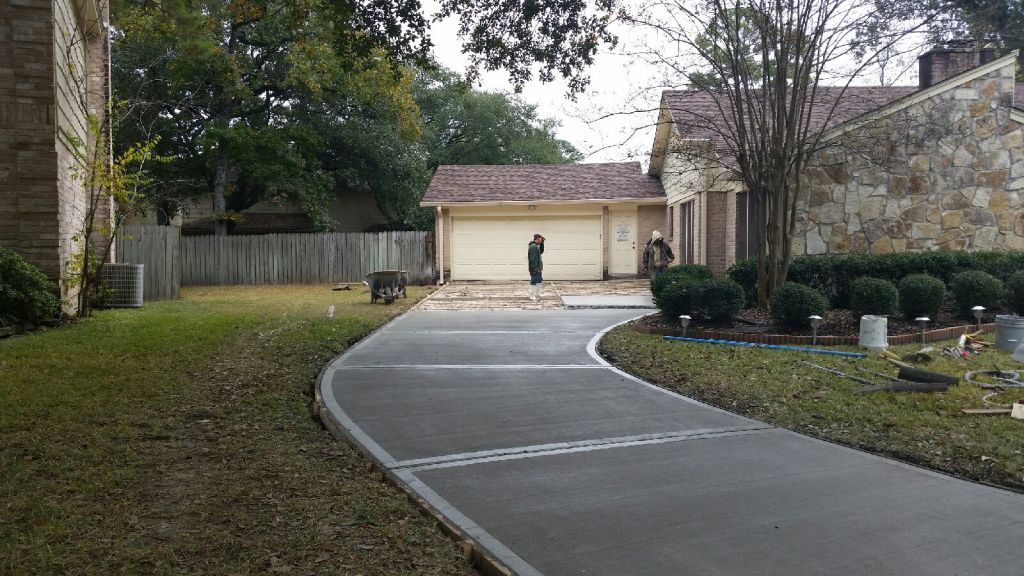Change Your Vision into Fact with a Relied On Concrete Contractor
Change Your Vision into Fact with a Relied On Concrete Contractor
Blog Article
The Environmentally Friendly Option: Concrete Sidewalks for Your Area
Concrete sidewalks are a common feature in the majority of neighborhoods, yet their effect on the environment is often forgotten. However, selecting concrete for your community sidewalks can make a significant difference in terms of sustainability and eco-friendliness. The advantages of going with concrete surpass plain appearances and performance. By considering the environmental advantages and long-lasting results on the area, the option of materials for pathways becomes an important decision. Allow's explore why concrete walkways may be the environmentally friendly option your neighborhood needs.
Benefits of Concrete Sidewalks
When taking into consideration the setup of pathways in an area, the advantages of choosing concrete over various other products are significant and many. Concrete walkways offer toughness, withstanding heavy foot website traffic, weather fluctuations, and ecological components much better than alternate products like asphalt or crushed rock. This durability translates to cost-effectiveness in the future, as concrete pathways need much less frequent repair work and upkeep. Additionally, concrete is a flexible material that can be easily personalized to match the aesthetic of any type of community via numerous coatings, colors, and patterns.

Longevity and Long Life
How can concrete walkways exceed other products in regards to longevity and longevity? Concrete sidewalks are renowned for their outstanding resilience and longevity contrasted to different materials like asphalt or pavers. The integral toughness of concrete makes it highly resistant to cracking, shifting, and general damage caused by foot traffic, weather condition fluctuations, and various other environmental aspects. Unlike asphalt, which can soften in heats and split in cold conditions, concrete maintains its architectural stability, needing minimal upkeep gradually.
In addition, concrete's sturdiness minimizes the need for constant repair services or replacements, making it a lasting and cost-efficient selection for community sidewalks. By spending in concrete sidewalks, areas can appreciate a trusted and lasting facilities that enhances the overall visual appeal and functionality of the location.
Low Maintenance Demands
Concrete walkways stick out for their very little upkeep requirements because of their long lasting nature and durable performance. Unlike alternate products that may require constant repair services or replacements, concrete sidewalks provide an affordable solution that requires little maintenance over time. One of the vital advantages of concrete sidewalks is their resistance to weathering and erosion. This indicates they can withstand rough climate conditions, heavy foot web traffic, and other environmental aspects without weakening rapidly.
Regular maintenance for concrete sidewalks typically entails straightforward jobs such as regular cleansing to get rid of debris and periodic securing to protect the surface area. In contrast to materials like asphalt or pavers that may move, fracture, or weaken even more conveniently, concrete sidewalks keep their architectural stability with very little intervention. Furthermore, any repairs that may be required are typically local and can be addressed swiftly, decreasing both the time and cost connected with upkeep.

Environmental Advantages
With a concentrate on sustainability and eco-friendliness, concrete sidewalks supply noteworthy ecological benefits that add to a greener community framework. Concrete is a product recognized for its toughness and longevity, decreasing the requirement for frequent substitutes. This longevity decreases the ecological impact related to the production and transport of brand-new products for pathway construction. In addition, concrete walkways have a high solar reflectance index, meaning they reflect a substantial amount of sunshine rather of preserving and absorbing warm. This high quality helps reduce the metropolitan warm island result, reducing energy consumption for cooling down structures and enhancing general convenience in city areas.
In addition, concrete is a porous material that enables water to infiltrate into the ground, reducing stormwater Continued overflow and aiding in groundwater recharge. This aids prevent disintegration, minimize flooding, and preserve the all-natural equilibrium of water supply in your area. By selecting concrete pathways, neighborhoods can make a sustainable selection that favorably influences the environment and improves the quality of life for residents.
Enhancing Neighborhood Sustainability
By prioritizing lasting facilities remedies, neighborhoods can grow an unified equilibrium in between ecological consciousness and area growth. Enhancing community sustainability includes a diverse technique that goes beyond just the environmental advantages of concrete walkways. Applying green rooms, advertising energy-efficient methods, and fostering a feeling of community interaction are crucial parts of developing a lasting area.
One method to improve community sustainability is through the assimilation of permeable concrete pathways. These sidewalks allow rainwater to seep right into the ground, decreasing stormwater drainage and reducing the stress on metropolitan water drainage systems. Concrete Contractor. By including absorptive pathways, communities can boost water high quality, decrease flooding threats, and boost total ecological resilience
In addition, advertising alternative transportation approaches such as walking and biking can considerably decrease carbon emissions and advertise a much healthier way of life among homeowners. Creating secure pedestrian pathways, bike lanes, and marked greenways can urge residents to rely much less on autos, even more adding to the area's sustainability objectives.
Conclusion
To conclude, concrete sidewalks use various benefits for neighborhoods, including longevity, low upkeep demands, and ecological benefits. By choosing concrete sidewalks, communities can enhance their sustainability and add to a much more eco-friendly setting. It is clear that concrete walkways are the perfect option for areas wanting to boost their this content infrastructure in a resilient and eco-friendly way.
When taking into consideration the setup of walkways in a community, the benefits of picking concrete over other products are many and considerable. Furthermore, concrete's longevity websites lowers the requirement for frequent repairs or replacements, making it a affordable and sustainable choice for neighborhood sidewalks (Concrete Contractor).With a focus on sustainability and eco-friendliness, concrete walkways offer noteworthy environmental benefits that add to a greener area facilities. Enhancing community sustainability entails a complex method that goes beyond simply the ecological benefits of concrete pathways.In verdict, concrete walkways provide countless benefits for communities, consisting of durability, reduced upkeep needs, and environmental benefits
Report this page